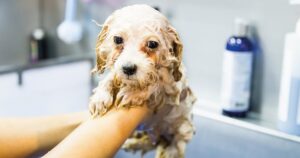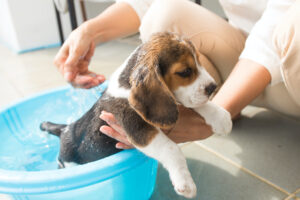If you’re a new pet parent, you’ve probably wondered, how often should you bathe a puppy? Puppies are playful, messy, and curious, which means bath time becomes a part of life. But it’s important not to overdo it or underdo it. In this guide, we’ll walk you through everything you need to know about bathing your puppy the right way.
Why Bathing a Puppy is Important
Bathing your puppy isn’t just about keeping them looking cute. It helps:
- Remove dirt and allergens
- Prevent skin problems
- Keep their coat healthy
- Strengthen your bond with them
However, how often should you bathe a puppy depends on several factors.

How Often Should You Bathe a Puppy?
The general rule is that you should bathe your puppy about once a month.
But how often should you bathe a puppy really depends on their:
- Age
- Fur type
- Lifestyle
- Health conditions
Some puppies need more frequent baths, while others can go longer between washes.
Factors That Influence Bathing Frequency
1. Age
Very young puppies, especially those under 8 weeks old, shouldn’t have full baths unless necessary. Use a soft cloth or grooming wipes instead. After 8 weeks, you can start regular baths using a puppy-safe shampoo.
2. Fur Type
Puppies with different fur types have different needs:

- Short-haired puppies (like Boxers) may need a bath every 4–6 weeks.
- Long-haired puppies (like Collies) may need a bath every 3–4 weeks.
- Curly-haired puppies (like Poodles) may need more frequent grooming and bathing every 2–4 weeks.
3. Lifestyle
Is your puppy a mud-lover or a cozy indoor type?
- Outdoor, active puppies will need more frequent baths.
- Indoor puppies can go longer between washes.
4. Skin Health
If your puppy has dry skin, allergies, or a skin condition, your vet may recommend a special bathing schedule. Always check before changing your puppy’s routine.
What Happens if You Bathe a Puppy Too Often?
Bathing your puppy too often can strip their skin of natural oils, leading to:
- Dryness
- Itching
- Irritation
It’s important to maintain a balance.
So, how often should you bathe a puppy? Enough to keep them clean, but not so much that their skin suffers.
Choosing the Right Puppy Shampoo
Always pick a shampoo made specifically for puppies.
Look for:
- Gentle, tear-free formulas
- pH-balanced for dogs
- No harsh chemicals
Human shampoos are too harsh and can upset your puppy’s sensitive skin.
How to Bathe Your Puppy Step-by-Step

Bathing your puppy the right way makes the experience positive and stress-free:
- Brush your puppy to remove tangles.
- Use lukewarm water.
- Wet your puppy gently, avoiding the ears and eyes.
- Apply a small amount of puppy shampoo.
- Lather and massage gently.
- Rinse thoroughly.
- Dry with a towel or a low-heat blow dryer.
Always praise your puppy after a bath! Treats work wonders too.
Tips for a Successful Puppy Bath
Use a non-slip mat in the tub or sink.
Protect their ears with cotton balls to prevent infections.
Start slow and let them get used to the water.
Keep calm so your puppy feels safe.
Signs Your Puppy Needs a Bath
Sometimes, you can tell it’s time for a bath before the schedule says so. Watch for:
- Visible dirt or mud
- Bad odor
- Excessive scratching
- Sticky or matted fur
When in doubt, a quick rinse with water or a gentle wipe-down can sometimes replace a full bath.
Professional Grooming vs. Home Baths
While you can easily bathe your puppy at home, some breeds or situations may call for professional grooming. If your puppy has thick, curly fur or severe matting, professional help ensures they stay healthy and comfortable.

Frequently Asked Questions About How Often Should you Bathe a Puppy
1.Can I bathe my puppy once a week?
While it might be tempting, bathing your puppy every week is usually too often unless recommended by your vet. Overbathing can dry out your puppy’s sensitive skin. A bath every 3–4 weeks is best for most puppies unless they get extra dirty or have a skin condition.
2. How do I keep my puppy clean between baths?
You can keep your puppy clean by:
- Brushing their fur regularly to remove dirt and loose hair
- Using puppy-safe grooming wipes for quick cleanups
- Spot-cleaning muddy paws or dirty areas with a damp cloth
Good hygiene doesn’t always require a full bath!
3. What if my puppy hates baths?
Many puppies are nervous at first. Try making bath time positive by:
- Using treats and praise
- Keeping water temperature warm, not hot
- Bathing them in a calm, quiet environment
- Going slowly and letting them explore the water at their own pace
Consistency and patience can turn bath time into a fun bonding activity.
4. Is it safe to bathe a puppy after vaccinations?
Yes, you can bathe a puppy after vaccinations, but it’s best to wait a couple of days. Vaccines can cause mild stress or tiredness, so give your pup time to rest before a bath unless it’s absolutely necessary.
5. How often should I bathe a puppy with sensitive skin?
If your puppy has sensitive skin, consult your vet.
Usually, puppies with skin issues should be bathed less frequently, using a gentle, medicated shampoo that soothes irritation.6. When should I start grooming my puppy professionally?
You can introduce your puppy to professional grooming around 12 weeks old, once they are comfortable with handling and light baths at home. Early grooming experiences help build confidence and good behavior at the groomer’s.
Conclusion: How Often Should You Bathe a Puppy?
How often should you bathe a puppy? In most cases, once every 3 to 4 weeks is a good rule of thumb. But remember—each puppy is unique. Their fur type, age, activities, and health all play a role in deciding the best bathing schedule.
By following the right steps, using gentle products, and paying attention to your puppy’s needs, bath time can become a fun and loving part of your life together.


